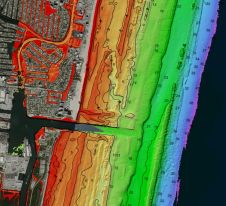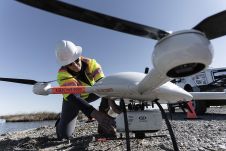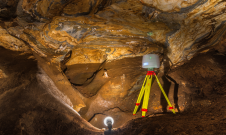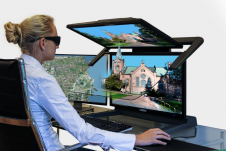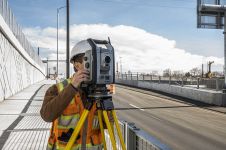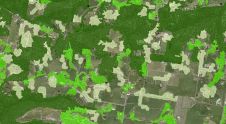3D Visualisation of Lidar Data
艺术和拟议系统
Over recent years the geo-community has used advances in hardware, software and memory to develop software for visualising remotely sensed data. Its 3D nature and capability for integration with other remotely sensed data at high resolution renders Lidar data ideal for 3D visualisation, particularly in an immersive environment. The authors review the state of the art in (geo-)visualisation techniques and propose a system, effectively an algorithm warehouse for an immersive visualisation interface for Lidar data.
搜索以3D-GI进行搜索,以允许3D查询和地理处理操作。已经试图概念化此类GIS对城市地区的拓扑要求。ERDA等软件Imagine Virtual GIS和ESRI ArcGIS已经合并了2.5D可视化。虚拟现实建模语言(VRML)/X3D技术已将第三个维度带到了万维网。
Display Methods
A visualisation interface gains popularity if the user is able to interact with it, change its para–meters and obtain various outputs. Geo-Visualisation or the visualisation of terrain on the computer has been used effectively for the generation of models for development planning, fire propagation, climate, air quality, public safety, communication networks, and traffic. Today interactive visualisation tools are being developed to aid decision-makers. Visual display methods may be broadly classified as:
- 2D plan view, represented by toposheets, thematic maps or digital elevation models; but showing the third dimension by height or class leads to loss of the other information
- 透视图3D视图,通过将对象投射到视图平面,然后将平面映射到显示屏上
- 立体视图,基于双眼视觉
- virtual reality, allowing a user to interact with computer-simulated environment.
In the sequel we focus on stereoscopic view and virtual reality.
立体镜检查
立体视图是通过安排使右眼图像和左眼的左眼图像显示的。主要技术(见图1)是(1)颜色多路复用,它利用了染色眼镜,(2)极化多路复用,它利用正交极化图像和(3)时光多路复用,可利用速度的快门玻璃50-60Hz,(4)时间和极化多路复用,这是时间和极化方法的混合物,以及(5)定位多路复用,使用以不同角度拍摄的地形照片。色谱镜检查基于光的分散:眼睛可能位于位于相同距离的不同颜色的不同距离对象。这些眼镜是高分散棱镜和低分散棱镜的组合。自动镜检查基于凸膜成像:在显示屏上构建了一系列长长的狭窄镜头,该屏幕将交错的图像朝不同方向发送,以便观察者可以在没有眼镜或其他附加组件的情况下可视化3D图像。但是,显示分辨率减半,并抑制图像的解释。最近的一种技术IRIS-3D使用了双通道投影系统,使两个立体声视图都能以完整分辨率显示;最重要的是,可以消除图像之间的串扰。((www.iris3d.com)。
Virtual Reality
大多数虚拟现实环境主要是英航sed on visual clues, displayed either on a computer screen or through stereoscopic displays. But some include additional clues, such as sound. With the advent of gaming engines, virtual-reality programming has become a popular market within the computer industry. The implementation of gaming engines in geospatial software has to some extent enabled immersive visualisation. Within a few years, monitors with 3D functionality might become consumer goods, as these are set to replace LCD flat panels and CRT screens. SeeReal Technologies of Dresden, Germany, has come up with SeeReal monitors that provide the facility for 3D viewing with the naked eye. Developments in processors, storage capacity, memory and graphics hardware is moving forward to further this capability.
地理性化
从广义上讲,地理化的要求是速度,准确性,可解释性,忠诚和月经。但是,鉴于较高和更高分辨率的传感器的持续发展以及由此产生的地理空间数据,3D可视化群体是否可视化?现在认为,地理科学可视化涵盖了空间数据可视化的理论,工具和方法的发展。GMBH的地理信息中心(www.cegi.de/) has showed that virtual reality may be applied in many areas (Figure 2). It may be divided into five classes: static, dynamic, interactive, animated and immersive. Software developers in the field of geo-visualisation have effectively leveraged scientific visualisation techniques. Landscape visualisation in 2.5D has been attempted in most geo-visualisation software.
Lidar
Three-dimensional immersive visualisation for Lidar data would be helpful in checking quality of data, but also for applications such as atmospheric science, bathymetric-data collection, law enforcement, telecommunications and disaster-management strategies. Though large volumes of data are being produced, fully automatic interpretation and mensuration methods do not seem an imminent possibility. 3D visualisation could lead to effective data mining and information extraction within a human-machine interface. The room-size visualisation system from Fujisaki, named Cave Automatic Virtual Environment (CAVE) and in which the user can make measurements of forest stands within the virtual environment is the only illustration of immersive visualisation using Lidar data.
Proposed System
There is a need for efficient and accurate processing of Lidar data within an immersive environment. We propose a system which can import and visualise raw Lidar data, use photographs to aid visualisation, create 3D visual models, enable editing/delineation of features and generate immersive fly-through scenes/animations (Figure 3). The aim is to design a black box that would take Lidar and photos as input and output a 3D-model. The Lidar data and aerial photographs would provide both texture and height information. The model would be tested with respect to visualisation ergonomics using existing and emergent visualisation methods. The possibility of integrating this model into a 3D-GIS environment would thus finally be explored. The data would first be procured and understood using commercial visualisation software (Erdas or Microstation); existent algorithms such as TIN and draped TIN would be evaluated for visualising Lidar data. The possibility of an emergent algorithm would be explored to address deficiencies in existing methods. This work would aim to come up with a new rendering method that enhances speed and increases interpretability of data. The end product might be a GIS Toolkit as an extension of existent GIS software. How might the system be quantified or benchmarked? This is difficult: a solution might be to quantify the visualisation experience with respect to specific benchmarks.
Concluding Remarks
In the near future it may become possible to take measurements and digitise features within the immersive environment. Spatial planning and decision-support systems (SPDSS), web-based 3D display, decision support and Lidargrammetry are waiting in the wings. With the aid of emergent technologies the user will soon have the facility for immersive visualisation and will be able to observe terrain to discover patterns and perform data mining, all with the naked eye.
进一步阅读
•CEGI,2003年,《莱茵河和Ruhr 2006的虚拟地区》(德语,原始标题:Machbarkeitsstudie,“ Virtuelle ainive a virtuelle a rhein a rhein und und Ruhr 2006”)。地球信息中心GmbH:代表北莱茵 - 西方州政府的可行性研究。多特蒙德。
•Fujisaki, I., Evans, D. L., Moorhead, R. J., Irby, D. W., Aragh, M. J. M. and Roberts, S. D., 2003, Lidar-based Forest Visualisation: Modelling Forest Stands and User Studies. In: ASPRS Annual Conference, Fairbanks, Alaska.
•Nielsen,E.,2006年。立体观看技术:地震技术。188金宝搏特邀Gim International,5月,第1卷。20,nr。5。
•Ostnes, R., Abbott, V. and Lavender, S., 2004, Visualisation Techniques: An Overview Parts 1 and 2. The Hydrographic Journal.
•Zlatanova,S.,2000。3DGIS用于城市发展。ISBN 90-6164-178-0,ITC,荷兰。














